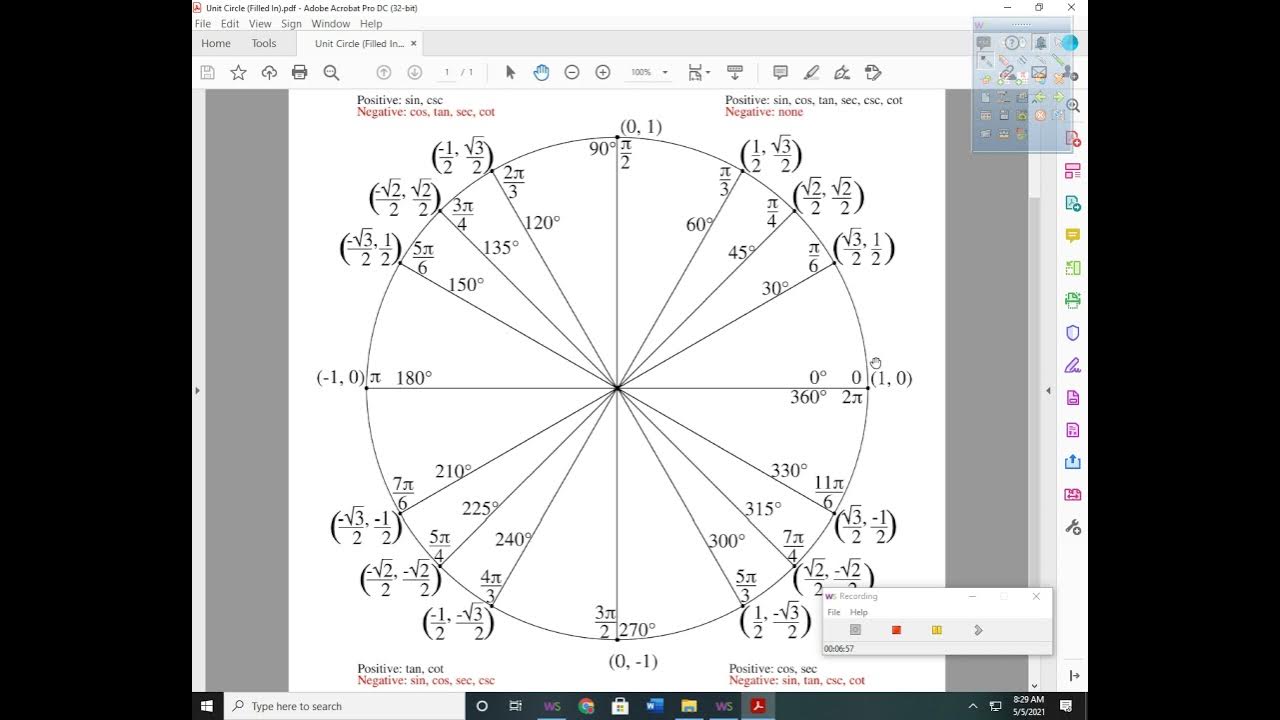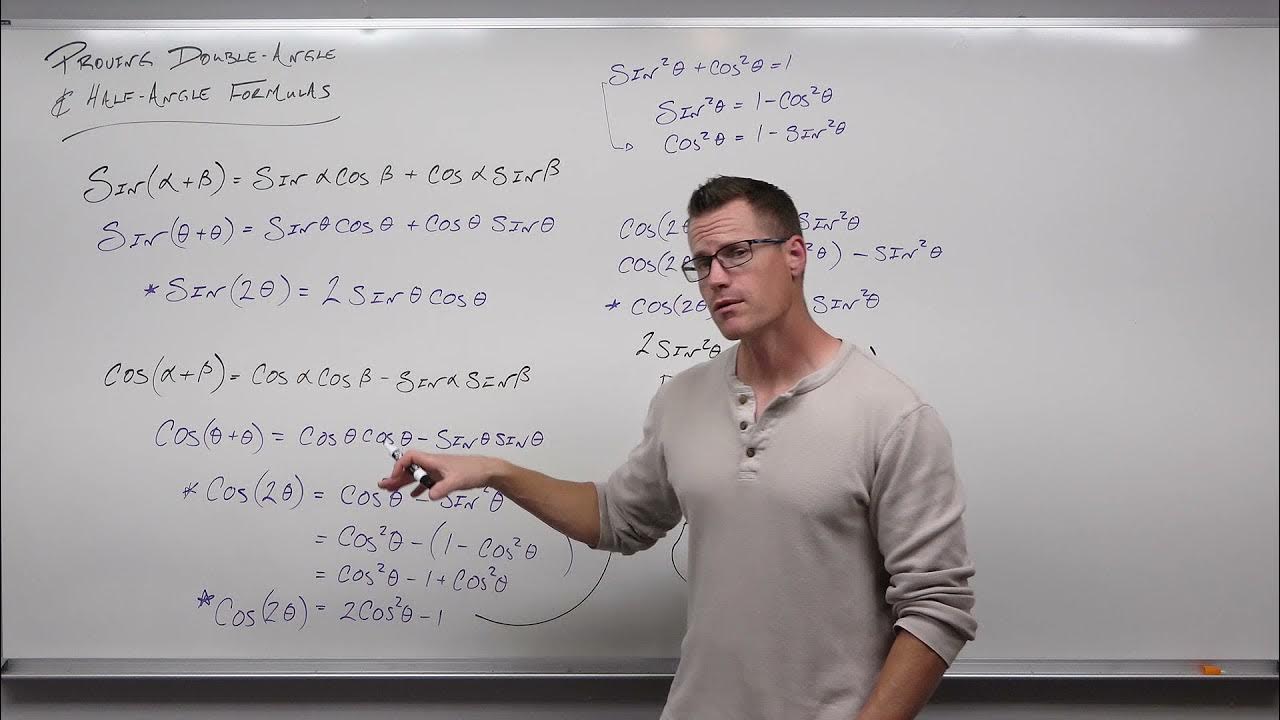5.4.1 Double-Angle Identities
TLDRIn this video, Mr. Banker explains double angle identities in trigonometry. He covers the double angle identities for sine and tangent, and three different identities for cosine, detailing when each is useful. Mr. Banker then proves the double angle identity for sine of 2u using the sine sum formula. He also demonstrates solving an equation involving a double angle by factoring and using unit circle properties to find solutions. This instructional video aims to enhance understanding of trigonometric identities and their applications in problem-solving.
Takeaways
- 📐 The double angle identity for sine is sin(2u) = 2sin(u)cos(u).
- 📏 The double angle identity for tangent is tan(2u) = 2tan(u)/(1 - tan^2(u)).
- 📏 There are three different double angle identities for cosine: cos(2u) = cos^2(u) - sin^2(u), cos(2u) = 2cos^2(u) - 1, and cos(2u) = 1 - 2sin^2(u).
- 🔍 The usefulness of each cosine double angle identity depends on the context of the problem being solved.
- 📚 The sine double angle identity can be derived using the sine sum formula: sin(2u) = sin(u + u) = sin(u)cos(u) + cos(u)sin(u) = 2sin(u)cos(u).
- 🧮 To solve an equation involving a double angle, such as sin(2x) = 2sin(x), start by subtracting 2sin(x) from both sides.
- 🔄 Replace sin(2x) with 2sin(x)cos(x) using the sine double angle formula.
- ⚙️ Factor out common terms to simplify the equation: 2sin(x)(cos(x) - 1) = 0.
- 🧩 Solve each factor separately: 2sin(x) = 0 and cos(x) - 1 = 0.
- 📊 Identify the angles where sin(x) = 0 and cos(x) = 1 using the unit circle, considering all coterminal angles: x = 0 + 2πn and x = π + 2πn.
Q & A
What is the double angle identity for sine of 2u?
-The double angle identity for sine of 2u is 2 sine(u) cosine(u).
What is the double angle identity for tangent of 2u?
-The double angle identity for tangent of 2u is 2 tangent(u) / (1 - tangent^2(u)).
How many double angle identities are there for cosine of 2u?
-There are three different double angle identities for cosine of 2u.
What is the first double angle identity for cosine of 2u?
-The first double angle identity for cosine of 2u is cosine^2(u) - sine^2(u).
What is the second double angle identity for cosine of 2u?
-The second double angle identity for cosine of 2u is 2 cosine^2(u) - 1.
What is the third double angle identity for cosine of 2u?
-The third double angle identity for cosine of 2u is 1 - 2 sine^2(u).
How does the video prove the double angle identity for sine of 2u?
-The video proves the double angle identity for sine of 2u by expressing sine(2u) as sine(u + u) and then using the sine sum formula.
What equation is used as an example to demonstrate solving with a double angle identity?
-The example equation used is sine(2x) = 2 sine(x).
How is the equation sine(2x) = 2 sine(x) simplified using the double angle identity?
-The equation is simplified by substituting sine(2x) with 2 sine(x) cosine(x), then factoring out 2 sine(x), resulting in 2 sine(x) (cosine(x) - 1) = 0.
What are the solutions to the equation after factoring?
-The solutions are sine(x) = 0, which gives x = 0 + 2πn and x = π + 2πn, and cosine(x) = 1, which gives x = 0 + 2πn.
What concepts from trigonometry are used to solve the equation sine(2x) = 2 sine(x)?
-Concepts used include double angle identities, factoring, and understanding of the unit circle to find where sine and cosine take specific values.
Outlines
📚 Introduction to Double Angle Identities
In this video, Mr. Banker introduces the concept of double angle identities, focusing on the sine and tangent functions. He explains the double angle identity for sine of 2-u, which is 2 sine of U cosine of U. He also mentions three different double angle identities for cosine of 2-u: cosine squared of U minus sine squared of U, two cosine squared of U minus one, and 1 minus 2 sine squared of U. He then proceeds to prove the double angle identity for sine of 2-u using the sine sum formula, demonstrating how it simplifies to 2 sine of U cosine of U. This sets the stage for solving equations involving double angles.
🔍 Solving Equations with Double Angle Identities
The video continues with an example of solving an equation involving a double angle, specifically sine of 2x equals 2 sine of X. Mr. Banker rearranges the equation to isolate the sine of 2x and then applies the double angle identity for sine, transforming it into 2 sine of X cosine of X minus 2 sine of X equals 0. He simplifies this to cosine of X minus 1 equals 0. Solving this equation, he finds that 2 sine of X equals 0 and cosine of X equals 1. He then interprets these results in terms of angles on the unit circle, identifying the solutions as zero and pi, and considering coterminal angles by adding multiples of 2 pi n. The video concludes with a summary of the solutions, emphasizing the importance of considering all coterminal angles.
Mindmap
Keywords
💡Double Angle Identities
💡Sine of 2u
💡Tangent of 2u
💡Cosine of 2u
💡Angle Sum Formula
💡Factoring
💡Unit Circle
💡Coterminal Angles
💡Periodicity
💡Trigonometric Equations
Highlights
Introduction to double angle identities in trigonometry.
Double angle identity for sine of 2u: 2 sine of U cosine of U.
Double angle identity for tangent of 2u: two times tangent of U over one minus tangent squared of U.
Three different double angle identities for cosine of 2u are discussed.
First cosine double angle formula: cosine squared of U minus sine squared of U.
Second cosine double angle formula: two cosine squared of U minus one.
Third cosine double angle formula: 1 minus 2 sine squared of U.
Proof of the double angle identity for sine of 2u using sine sum formula.
Solving an equation with a double angle: sine of 2x equals 2 sine of X.
Isolating variables in the equation sine of 2x minus 2 sine of X equals 0.
Using sine double angle formula to replace sine of 2x.
Factoring out 2 sine of X and simplifying the equation.
Setting each factor equal to zero to find solutions.
Solving for sine of X equals 0 and finding angles where Y value is 0.
Considering coterminal angles with a period of 2 pi.
Solving for cosine of X equals one and finding angles where X value is 1.
Final solution includes zero plus two pi n and pi plus 2 pi n.
Conclusion and summary of the video's content.
Transcripts
Browse More Related Video

5.5 Multiple Angle and Product to Sum Formulas (Part 1)

Inverse Trig Functions With Double Angle Formulas and Half Angle Identities - Trigonometry

5.1.4 Odd-Even Identities

Ultimate trig identity problem study guide!

How to Use the Double and Half Angle Formulas for Trigonometry (Precalculus - Trigonometry 28)

Proving the Double and Half Angle Formulas for Trigonometry (Precalculus - Trigonometry 27)
5.0 / 5 (0 votes)
Thanks for rating: